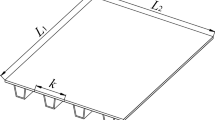Abstract
The collapse of a 2-span steel pedestrian bridges caused by a truck collision is investigated and studied in detail using a Nonlinear Finite Element program. Typical bridge widely used in Jordan is studied and modeled under vehicle collision using one dimensional beam finite element in order to minimize analysis time due to the dynamic nature of the problem. Truck collision with the bridge is simulated at different speeds and locations of collisions using dynamic explicit finite element scheme with material nonlinearity taken into account. Energy absorption of bridge is investigated through principle of energy conservation, where truck kinetic energy is assumed to be stored in the bridge as strain energy. Weak failure points in the bridges were identified, and modifications are proposed in order to strengthen the bridge structure and prevent total collapse. The proposed design modifications on bridge structure were successful in allowing the bridge to fail locally rather than globally and expected to help in saving lives.
Similar content being viewed by others
References
ABAQUS (2005). User manual, Version 6.3, Habbitt, Karlsson and Sorensen, Inc., Providence, RI.
Atahan, A. and Cansiz, O. (2005). “Impact analysis of a vertical flared back bridge rail-to-guardrail transition structure using simulation.” Finite Elements in Analysis and Design, Vol. 41, pp. 371–396, DOI: 10.1016/j.finel.2004.07.003
Consolazio, G. and Cowan, D. (2003). “Nonlinear analysis of barge crush behavior and its relationship to impact resistant bridge design.” Computers and Structures, Vol. 81, pp. 547–557, DOI: 10.1016/S0045-7949(02)00474-1
Juozapaitis, A., Vainiunas, P., and Kaklauskas, G. (2006). “A new steel structural system of a suspension pedestrian bridge.” Journal of Constructional Steel Research, Vol. 62, pp. 1257–1263, DOI: 10.1016/j.jcsr.2006.04.023
Kwasniewski, L., Li, H., Wekezer, J., and Malachowski, J. (2006). “Finite element analysis of vehicle-bridge interaction.” Finite Elements in Analysis and Design, Vol. 42, pp. 950–959, DOI: 10.1016/j.finel.2006.01.014
Rust, W. and Schweizerhof, K. (2003). “Finite element limit load analysis of thin-walled structures by ANSYS (implicit), LS-DYNA (explicit) and in combination.” Thin-Walled Structures, Vol. 41, pp. 227–244, DOI: 10.1016/S0263-8231(02)00089-7.
Wang, L., Yang, L., Huang, D., Zhang, Z., and Chen, G. (2008). “An impact dynamics analysis on a new crashworthy device against shipbridge collision.” International Journal of Impact Engineering, Vol. 35, pp. 895–904, DOI: 10.1016/j.ijimpeng.2007.12.005.
Author information
Authors and Affiliations
Corresponding author
Rights and permissions
About this article
Cite this article
Almasri, A.H., Alrousan, R.Z. & Manasrah, Ah. Finite element analysis of a 2-span pedestrian bridge collapse due to trucks collision. KSCE J Civ Eng 19, 1845–1851 (2015). https://doi.org/10.1007/s12205-014-1119-5
Received:
Revised:
Accepted:
Published:
Issue Date:
DOI: https://doi.org/10.1007/s12205-014-1119-5




